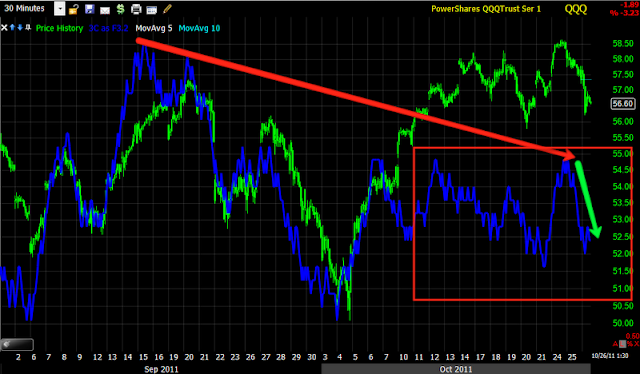When I said I think something is up, it was hard to put in to words, but this ES chart may be worth a thousand words.
From left to right, we see the same negative divergence on the open in ES as in the market, there was pretty good volume there and a ramp on news just before, those may have been some significant losses taken early this a.m., remember ES trades about 1.1 billion contracts a day at 50x the price of the S&P 500 (as of the close about $62,100 per single contract).
I just did some tedious rough math based on the volume of contracts and an average price for each 15 min time period (high of the period minus low of the period divided by 2 and added or subtracted to the high or low depending on whether the market was heading down or up). In essence, I calculated the average share price per 15 minute time period-tedious.
This is filled with assumptions, but it's meant more to be an example then anything else. We started off the day with good news and thus we can assume there was an intraday long position, what that would have been I have no idea, but the negative divergence on the open sent the market lower and the volume multiplied by the average contract price would have led to a loss of $953,340,349 (the real number would be multiplied by 50, but for ease of example, we'll just go with this)
Morning loss of $953,340,349
Midday accumulation according to 3C $570,748,461
This is where it gets tricky because it's hard to say where the most distribution of shares would have been (at what price level)
Afternoon distribution would have been $1,438,526,452
Less the cost basis of accumulated shares= $867,777,991
Conclusions: Even though this is very rough math, the morning loss would have been $953,340,349
After accumulating near the lows and subtracting that cost, the afternoon net profit would have been around $867,777,991 or a difference of -$85,562,358 rather then over 10x that amount.
So however you figure the math and it's really impossible to know, you can see a clear incentive to lift the market in the afternoon to make up for massive losses sustained in the morning. No matter how far off my assumptions may be, there's clearly an incentive. I think this also has something to do with why we saw the downside in the morning break with the typical EUR/USD correlation that has been so strong, if that correlation had held, the losses would have been far, far greater. I also think this is part of the reason that the correlation in the afternoon was broken as well, except this time instead of the market running behind the correlation, it was running far in front of the correlation-in essence playing defense on the way down and playing catch up on the way up.
I have been struggling for some time to create a version of 3C that can essentially compare the volume/dollars of a negative divergence vs the same for a positive divergence. I just did that more or less by hand and that's what I came up with.
I think it also partly explains why USO lagged the market so badly, when they are both correlated to the same thing, further evidence of the market running in front of the EUR correlation in the afternoon.
This is USO in green vs the SPY in red. The white box is an example of the daily mismatch between yesterday's EUR/Market close in which the market "if the correlation had held) would have been much, much lower. And in the red box, you can see how the market is playing catch up and running ahead of USO exactly at 1 p.m. right after the accumulation period would have ended and the rally started.
As a further example, the EUR/USD correlation to the Dow-30 is 1 FX pip equals roughly 2 Dow points.
Today in the early EUR/USD sell-off, from open to low, there was a -157 pip move. This would equal negative 314 Dow points. Instead the Dow lost an incredible -13.32 points from open to low!
If we take the morning high to the morning low of the EUR/USD we saw a loss of 175 pips that would equal 350 DOW points.
Instead, the DOW from morning high to morning low lost 172 points about half the normal correlation.
By contrast the Dow rallied off its low to the close by 196 points. The EUR rallied of its low to close by 110 pips-much closer to the correlation, in fact only 24 points off, whereas the previous example in the morning was off by 300 points!
I don't know what the correlations for the S&P-500, NASDAQ 100 and Russell 200 are, but in terms of percentage I would imagine they would track the same as the Dow-30. Not so in today's rally off the lows to the close, here are the results:
DOW-30 (which in the afternoon rally was very lose to the 2 point correlation) +1.4%
SP-500 +1.7%
The NASDAQ 100 +1.86%
The Russell 2000 +2.7%!!! Nearly double the DOW and presumably nearly double the correlation between the Euro and Russell 2000!
So those strange things I was noticing today, but didn't have time to figure out what they were, here's what they were.





















































